april-top.html
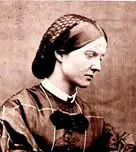 1827 Mary Ward was born on this day in County Offaly in 1827. She took a keen interest in science as a child, and took every opportunity she could to visit her cousin, William Parsons, who was building a large telescope.
1827 Mary Ward was born on this day in County Offaly in 1827. She took a keen interest in science as a child, and took every opportunity she could to visit her cousin, William Parsons, who was building a large telescope.
Ward was also an excellent artist, and sketched the manufacture of the telescope at each stage. The sketches were so detailed and accurate, they were used as a guide to build a replica of the telescope in the early 2000s.
Her father bought her a microscope and Ward spent most of her waking life, studying insects and often sketching them in incredible detail. At the time, women were not accepted by universities, so Ward educated herself in several areas of science, by reading essays by leading professors and writing personal letters to them to request more details.

Ward also wrote books herself, although she doubted they would be published because she was a woman and had no formal education. However, her first book ‘Sketches with the Microscope’ was so well received that it was repeatedly reprinted for sale for more than 20 years after it was first published.
Unfortunately, Ward met a tragic end when she was travelling in a steam-powered motor car with her cousin William Parsons’ son. Motor cars were heavy and slow at the time, and had generally been abandoned except by enthusiasts. Ward was thrown from the vehicle at a bend in the road and fell under the wheels, killing her almost instantly.
Visitors to County Down, can see Ward’s microscope, sketches and slides and books at a display at Castle Ward.
Click here to read about more great Irish scientists
Click here to read about more tourist attractions in Ireland
* * *
1887 Harry Boland was born on this day in Dublin in 1887. He was a member of the Irish Republican Brotherhood, as were his brothers and his father. His brother Ned fought for the Irish nationalists in the Easter Rising 1916. Boland was a good friend of Michael Collins and worked closely with him during the Irish War of Independence. However, both fell for the same woman, the beautiful Kitty Kiernan, and when she chose to be with Collins their relationship became strained.
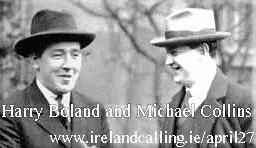 When Michael Collins signed the Anglo-Irish Treaty, Boland turned against him and sided with the anti-Treaty faction of the now split IRA. The signing of the Treaty had sparked a civil war, with both factions of the IRA now fighting against each other. Boland was killed when his hotel room was stormed by soldiers and he was fatally wounded. His death affected Collins who sought to negotiate a peace deal with anti-Treaty leader Éamon de Valera. However, Collins was killed in an ambush less than three weeks later.
When Michael Collins signed the Anglo-Irish Treaty, Boland turned against him and sided with the anti-Treaty faction of the now split IRA. The signing of the Treaty had sparked a civil war, with both factions of the IRA now fighting against each other. Boland was killed when his hotel room was stormed by soldiers and he was fatally wounded. His death affected Collins who sought to negotiate a peace deal with anti-Treaty leader Éamon de Valera. However, Collins was killed in an ambush less than three weeks later.
Click here to read more about the Easter Rising
Click here to read the love story of Michael Collins and Kitty Kiernan
* * *
1891 Ireland’s first ever musical comedy was performed at the Queen’s Theatre in Dublin on this night in 1891. The Irish Girl was written by Doctor W Houston Collisson and Percy French, the man who wrote the brilliant comedy Irish songs, Phil the Fluther’s Ball and Abdul Abulbul Amir.
Click here to read more about Percy French
Click here to read about how French came to write Phil the Fluther’s Ball
Click here to watch Brendan O’Dowda’s superb performance of Abdul Abulbul Amir
* * *
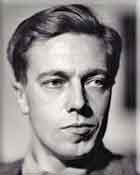 1905 Cecil Day-Lewis was born in Ireland on this day in 1905. Differing sources claim his birth county to be Sligo, Laois or Mayo. He held the position of Poet Laureate from 1968 until his death in 1972. He was also was a novelist using the pseudonym Nicholas Blake.
1905 Cecil Day-Lewis was born in Ireland on this day in 1905. Differing sources claim his birth county to be Sligo, Laois or Mayo. He held the position of Poet Laureate from 1968 until his death in 1972. He was also was a novelist using the pseudonym Nicholas Blake.
One of his sons is multiple Oscar winning actor Daniel Day-Lewis.
Click here to read the list of Ireland’s 100 favourite poems
Click here to read about great Irish writers
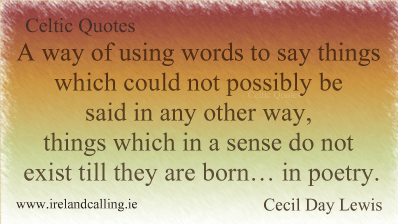
* * *
1953 Maud Gonne, the beautiful actress and Irish nationalist, died on this day in 1953. She was born in England but moved to Ireland with her father when he was stationed there with the army. She felt for the Irish people as they struggled to break free from the British rule.
Gonne met WB Yeats and he immediately fell in love with her. However, Gonne married French politician, Lucien Millevoye and they had two children.
Gonne performed as the Old Woman of Ireland in Yeats’ play Cathleen Ní Houlihan, and he asked her to marry him several times after she separated from Millevoye. But Gonne repeatedly turned him down. Yeats told her he wasn’t happy without her, to which she responded:
“Oh yes, you are, because you make beautiful poetry out of what you call your unhappiness and are happy in that. Marriage would be such a dull affair. Poets should never marry. The world should thank me for not marrying you.”
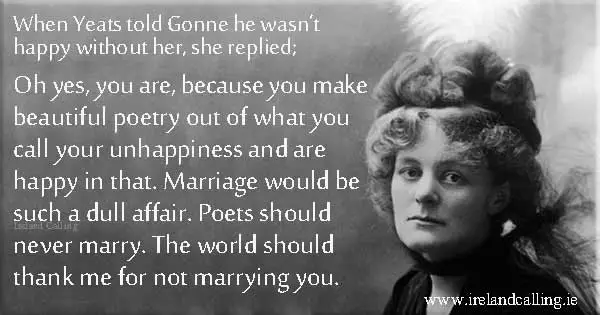
Yeats did write some brilliant poems inspired by his love for Gonne and his frustration that he couldn’t have her. When You Are Old was written to warn her that she wouldn’t always have her youthful beauty, and may wish she had accepted Yeats when she had the chance. He Wishes for the Cloths of Heaven was also written about Gonne, and was voted Ireland’s second favourite poem in a poll by the Irish Times.
Gonne did get married again, but to Irish nationalist Major John MacBride, and they had a son together. However, their marriage lasted only a short while, and Gonne tried to get a divorce claiming MacBride had been violent towards her and also molested her then 11 year old daughter. These claims couldn’t be proven in court so Gonne fled to France to get her and her family away from MacBride.
She returned to Ireland in 1916, once he had been executed for his part in the Easter Rising. Yeats asked her one final time to be his wife, but again she refused him. Oddly, Yeats reacted by proposing to Gonne’s now 22 year-old daughter Iseult, who followed her mother’s lead and declined.
Click here to read more about the relationship between WB Yeats and Maud Gonne
Click here to read about the Easter Rising
Click her to read more about WB Yeats
Click here to read He Wishes for the Cloths of Heaven
Click here to read When You Are Old
* * *
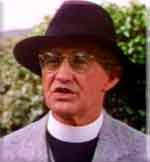 1970 Dublin-born film star Arthur Shields died on this day in 1970. He had taken part in the Easter Rising of 1916 as a young man, as Irish nationalists fought for their independence from Britain.
1970 Dublin-born film star Arthur Shields died on this day in 1970. He had taken part in the Easter Rising of 1916 as a young man, as Irish nationalists fought for their independence from Britain.
He was imprisoned in Wales and upon his release he moved back to Dublin and worked as an actor at the Abbey Theatre. Shields was invited to America by John Ford to appear in a film version of The Plough and the Stars.

He went on to appear in several more movies, including Lady Godiva, She Wore a Yellow Ribbon and The Quiet Man (in his role as Protestant clergyman Reverend Playfair), where he starred opposite John Wayne and Maureen O’Hara.
Click here for more about Arthur Shields life and career
Click here to read more about the Easter Rising
Click here to read about more Irish actors
april-bottom.html